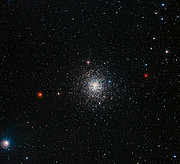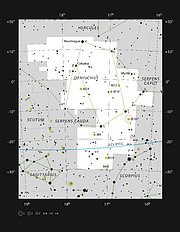Press Release
A Swarm of Ancient Stars
8 December 2010
We know of about 150 of the rich collections of old stars called globular clusters that orbit our galaxy, the Milky Way. This sharp new image of Messier 107, captured by the Wide Field Imager on the 2.2-metre telescope at ESO’s La Silla Observatory in Chile, displays the structure of one such globular cluster in exquisite detail. Studying these stellar swarms has revealed much about the history of our galaxy and how stars evolve.
The globular cluster Messier 107, also known as NGC 6171, is a compact and ancient family of stars that lies about 21 000 light-years away. Messier 107 is a bustling metropolis: thousands of stars in globular clusters like this one are concentrated into a space that is only about twenty times the distance between our Sun and its nearest stellar neighbour, Alpha Centauri, across. A significant number of these stars have already evolved into red giants, one of the last stages of a star’s life, and have a yellowish colour in this image.
Globular clusters are among the oldest objects in the Universe. And since the stars within a globular cluster formed from the same cloud of interstellar matter at roughly the same time — typically over 10 billion years ago — they are all low-mass stars, as lightweights burn their hydrogen fuel supply much more slowly than stellar behemoths. Globular clusters formed during the earliest stages in the formation of their host galaxies and therefore studying these objects can give significant insights into how galaxies, and their component stars, evolve.
Messier 107 has undergone intensive observations, being one of the 160 stellar fields that was selected for the Pre-FLAMES Survey — a preliminary survey conducted between 1999 and 2002 using the 2.2-metre telescope at ESO’s La Silla Observatory in Chile, to find suitable stars for follow-up observations with the VLT’s spectroscopic instrument FLAMES [1]. Using FLAMES, it is possible to observe up to 130 targets at the same time, making it particularly well suited to the spectroscopic study of densely populated stellar fields, such as globular clusters.
M107 is not visible to the naked eye, but, with an apparent magnitude of about eight, it can easily be observed from a dark site with binoculars or a small telescope. The globular cluster is about 13 arcminutes across, which corresponds to about 80 light-years at its distance, and it is found in the constellation of Ophiuchus, north of the pincers of Scorpius. Roughly half of the Milky Way’s known globular clusters are actually found in the constellations of Sagittarius, Scorpius and Ophiuchus, in the general direction of the centre of the Milky Way. This is because they are all in elongated orbits around the central region and are on average most likely to be seen in this direction.
Messier 107 was discovered by Pierre Méchain in April 1782 and it was added to the list of seven Additional Messier Objects that were originally not included in the final version of Messier’s catalogue, which was published the previous year. On 12 May 1793, it was independently rediscovered by William Herschel, who was able to resolve this globular cluster into stars for the first time. But it was not until 1947 that this globular cluster finally took its place in Messier’s catalogue as M107, making it the most recent star cluster to be added to this famous list.
This image is composed from exposures taken through the blue, green and near-infrared filters by the Wide Field Camera (WFI) on the MPG/ESO 2.2-metre telescope at the La Silla Observatory in Chile.
Notes
[1] Fibre Large Array Multi-Element Spectrograph
More information
ESO, the European Southern Observatory, is the foremost intergovernmental astronomy organisation in Europe and the world’s most productive astronomical observatory. It is supported by 14 countries: Austria, Belgium, Czechia, Denmark, France, Finland, Germany, Italy, the Netherlands, Portugal, Spain, Sweden, Switzerland and the United Kingdom. ESO carries out an ambitious programme focused on the design, construction and operation of powerful ground-based observing facilities enabling astronomers to make important scientific discoveries. ESO also plays a leading role in promoting and organising cooperation in astronomical research. ESO operates three unique world-class observing sites in Chile: La Silla, Paranal and Chajnantor. At Paranal, ESO operates the Very Large Telescope, the world’s most advanced visible-light astronomical observatory and VISTA, the world’s largest survey telescope. ESO is the European partner of a revolutionary astronomical telescope ALMA, the largest astronomical project in existence. ESO is currently planning a 42-metre European Extremely Large optical/near-infrared Telescope, the E-ELT, which will become “the world’s biggest eye on the sky”.
Links
Contacts
Richard Hook
ESO, La Silla, Paranal, E-ELT and Survey Telescopes Public Information Officer
Garching, Germany
Tel: +49 89 3200 6655
Cell: +49 151 1537 3591
Email: rhook@eso.org
About the Release
| Release No.: | eso1048 |
| Name: | Messier 107 |
| Type: | Solar System : Star : Grouping : Cluster : Globular |
| Facility: | MPG/ESO 2.2-metre telescope |
| Instruments: | WFI |
Our use of Cookies
We use cookies that are essential for accessing our websites and using our services. We also use cookies to analyse, measure and improve our websites’ performance, to enable content sharing via social media and to display media content hosted on third-party platforms.
ESO Cookies Policy
The European Organisation for Astronomical Research in the Southern Hemisphere (ESO) is the pre-eminent intergovernmental science and technology organisation in astronomy. It carries out an ambitious programme focused on the design, construction and operation of powerful ground-based observing facilities for astronomy.
This Cookies Policy is intended to provide clarity by outlining the cookies used on the ESO public websites, their functions, the options you have for controlling them, and the ways you can contact us for additional details.
What are cookies?
Cookies are small pieces of data stored on your device by websites you visit. They serve various purposes, such as remembering login credentials and preferences and enhance your browsing experience.
Categories of cookies we use
Essential cookies (always active): These cookies are strictly necessary for the proper functioning of our website. Without these cookies, the website cannot operate correctly, and certain services, such as logging in or accessing secure areas, may not be available; because they are essential for the website’s operation, they cannot be disabled.
Functional Cookies: These cookies enhance your browsing experience by enabling additional features and personalization, such as remembering your preferences and settings. While not strictly necessary for the website to function, they improve usability and convenience; these cookies are only placed if you provide your consent.
Analytics cookies: These cookies collect information about how visitors interact with our website, such as which pages are visited most often and how users navigate the site. This data helps us improve website performance, optimize content, and enhance the user experience; these cookies are only placed if you provide your consent. We use the following analytics cookies.
Matomo Cookies:
This website uses Matomo (formerly Piwik), an open source software which enables the statistical analysis of website visits. Matomo uses cookies (text files) which are saved on your computer and which allow us to analyze how you use our website. The website user information generated by the cookies will only be saved on the servers of our IT Department. We use this information to analyze www.eso.org visits and to prepare reports on website activities. These data will not be disclosed to third parties.
On behalf of ESO, Matomo will use this information for the purpose of evaluating your use of the website, compiling reports on website activity and providing other services relating to website activity and internet usage.
Matomo cookies settings:
Additional Third-party cookies on ESO websites: some of our pages display content from external providers, e.g. YouTube.
Such third-party services are outside of ESO control and may, at any time, change their terms of service, use of cookies, etc.
YouTube: Some videos on the ESO website are embedded from ESO’s official YouTube channel. We have enabled YouTube’s privacy-enhanced mode, meaning that no cookies are set unless the user actively clicks on the video to play it. Additionally, in this mode, YouTube does not store any personally identifiable cookie data for embedded video playbacks. For more details, please refer to YouTube’s embedding videos information page.
Cookies can also be classified based on the following elements.
Regarding the domain, there are:
- First-party cookies, set by the website you are currently visiting. They are stored by the same domain that you are browsing and are used to enhance your experience on that site;
- Third-party cookies, set by a domain other than the one you are currently visiting.
As for their duration, cookies can be:
- Browser-session cookies, which are deleted when the user closes the browser;
- Stored cookies, which stay on the user's device for a predetermined period of time.
How to manage cookies
Cookie settings: You can modify your cookie choices for the ESO webpages at any time by clicking on the link Cookie settings at the bottom of any page.
In your browser: If you wish to delete cookies or instruct your browser to delete or block cookies by default, please visit the help pages of your browser:
Please be aware that if you delete or decline cookies, certain functionalities of our website may be not be available and your browsing experience may be affected.
You can set most browsers to prevent any cookies being placed on your device, but you may then have to manually adjust some preferences every time you visit a site/page. And some services and functionalities may not work properly at all (e.g. profile logging-in, shop check out).
Updates to the ESO Cookies Policy
The ESO Cookies Policy may be subject to future updates, which will be made available on this page.
Additional information
For any queries related to cookies, please contact: pdprATesoDOTorg.
As ESO public webpages are managed by our Department of Communication, your questions will be dealt with the support of the said Department.



